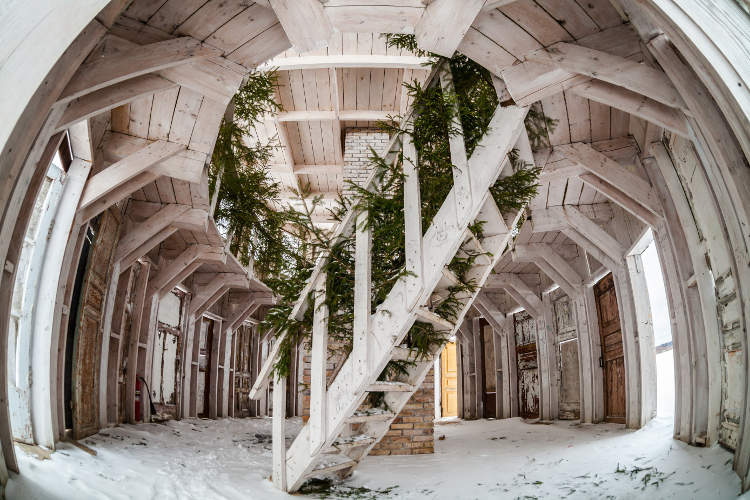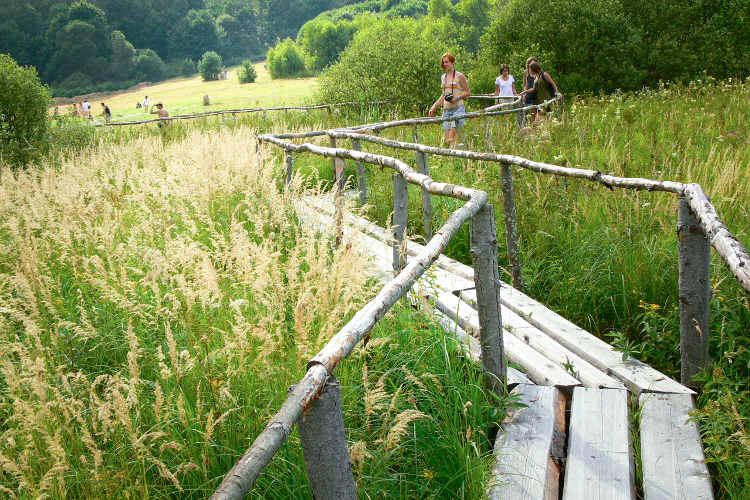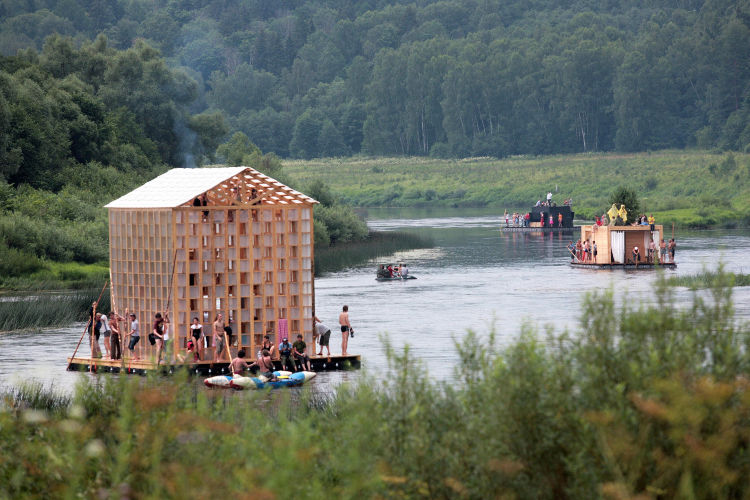You could call it abstract architecture. Towering over the canopy, the structures make the whole place look like an abandoned arboreal city of Ewoks – those bear-like creatures in the original Star Wars who help Luke Skywalker fight the Empire. If you don’t mind creaky planks and steep ladders, you can climb most of them – an easy way to boost adrenalin and get a few heroic selfies. If the structures (most of which are made without a single nail) feel slightly unstable, console yourself with the fact that they’ve been designed by some of the most sought-out contemporary architects in the country.

The centrepiece is the Universal Mind, a massive temple-like structure designed by one the project’s founders, Nikolay Polissky. Preceded by an avenue lined with wooden pillars, it’s made of convoluted tree branches and resembles a giant human brain. Connecting the branches are metal plates which catch the light of the setting sun, making the whole construction shine like a gold nugget.
In the adjacent field, the Gilded Calf (authored by another Nikola-Lenivets founding father, Vasily Shchetinin) resembles a caravelle or a bull – depending on the angle you’re looking from. The artist says he mused over what the Charging Bull statue in New York’s Wall Street would look like at the time of a financial meltdown. He imagined that the bull would turn into a new Noah’s ark which brings people back from the sea of greed to the land that nurtured them in the ancient past. Most of the structures are located along a circular route running through the forest. The entrance is across the road from the Universal Mind.

The village itself (about 200km southwest of Moscow, in Kaluga region) sits on the high bank of the sleepy Ugra River, which bends sharply right under the recently restored classicist Trinity Church and disappears into the dense forest of Ugra National Park. Thousands flock to Nikola-Lenivets for the annual Archstoyanie (arch.stoyanie.ru) international festival in summer (dates vary), when new objects are presented and everyone parties big time.
There’s a reception office, where you can buy maps and hire bicycles, at the main turn to the village. Nearby stands a windowless but airy wooden structure that could well have been one of the art objects if it weren’t a hostel with several rooms, a penthouse and bunkbeds in perimetre galleries.

Another reception office is at the far end of the road, near a collection of wooden huts and large tents which can be booked for overnight stays. There are several types of huts of varying degrees of comfort (or rather, spartan simplicity), but united by the spirit of architectural experiment and Scandinavian design influences.
A modern cafe nearby is a good place to chill out, but you’ll miss out on a great dining experience if you skip Ferma, some 500m further along the dirt track. It’s a real farm run by lumberjack-hipster Sergey Morozov and his wife Anna. Garden produce travels not far from where it grows to a makeshift field kitchen and ends up on a long communal table as delicious soups and salads, or it’s served with pasta (which is handmade right on the spot). There’s also a great selection of homemade drinks, including the superb rhubarb kompot (a sweet soft drink) and potent samogon – the strong booze Russian villagers have traditionally produced and consumed for centuries.

Getting to Nikola-Lenivets is part of the fun and it’s not easy. Your best bet is to hire a car from one of the global rental agencies in Moscow and head out on your own. Exit the city via Leninsky Prospekt, which becomes Kyiv highway once you’re out of town. After about 100km, turn right to Medyn. Upon reaching it, turn to Kondrovo, from where Nikola-Lenivets signs will lead you along some of Russia’s bumpiest roads to the final destination. The trip takes just over three hours. As ever with travelling to and from Moscow, keep in mind the horrendous traffic jams – avoid the weekends whenever possible, leave the city in the morning and return in the evening (but not on Sunday). The Russian Yandex navigation app monitors traffic jams in real time and suggests the fastest route.
There’s no public transport going directly to Nikola-Lenivets. You’ll need to get an elektrichka commuter train from Kievsky Vokzal in Moscow to Maloyaroslavets, then book one of the drivers familiar with the road – you’ll find them on the Nikola-Lenivets website (nikola-lenivets.com). Alternatively, if you don’t speak Russian, contact Nikola-Lenivets reception directly and try to get them arrange it for you.